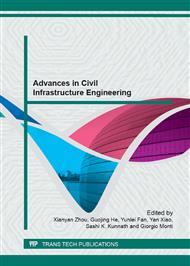p.359
p.364
p.368
p.372
p.377
p.382
p.389
p.394
p.399
Modeling Analysis of Crack Repairing Structures for Asphalt Concrete Pavement
Abstract:
Crack is one of the major distresses in asphalt concrete pavements, which could significantly reduce the safety and amenity of driving, even the performance of the whole pavement structure. By means of diverse crack repairing manners, the durability and whole service life of the pavement can be improved and extended. After repairing, a composite structure of the repairing system is formed which consists of new crack filling materials and original asphalt concrete matrixes. In order to resist the external loads on the pavement, the composite structure mush work as an integrated structure and maintain sufficient adhesive strength. Therefore, the deformation compatibility of the composite structure is the vital performance for the stability and durability of the entire repairing system. In this study, a modeling analysis for the composite structure under various service conditions was carried out utilizing MIDAS software. The vertical and transverse deformation, transverse and longitudinal normal stress were analyzed by simulating the composite structure under several serving conditions. Based on the results,it was found that the strain, stress and related properties of the repair material and asphalt concrete matrixes could meet the requirements for an asphalt concrete pavement, and the compatibility of the composite structure was also satisfactory.
Info:
Periodical:
Pages:
377-381
Citation:
Online since:
January 2013
Price:
Сopyright:
© 2013 Trans Tech Publications Ltd. All Rights Reserved
Share:
Citation:


